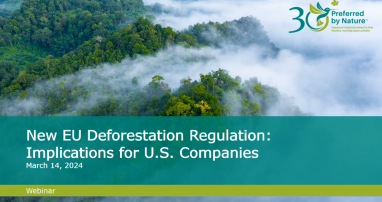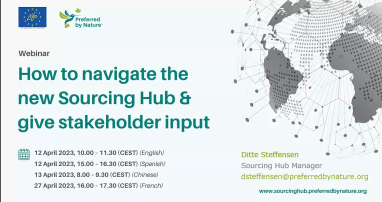Jump to a specific section:
What is the EUDR
Is the EUDR applicable to me
When do I need to be ready?
What about the EUTR?
Which commodities are in the EUDR's scope?
Which products are covered by the EUDR?
Which products are exempted from the EUDR?
What is the EUDR?
On 29 June 2023, a new law came into force in the European Union, to prevent companies from placing commodities linked with deforestation and forest degradation, onto the EU market, or exporting them from the EU.
This law arose in response to the fact that deforestation for agriculture, and forest degradation are contributing to climate change, biodiversity loss, and other urgent environmental challenges:

Between 1990 and 2020, 420 million hectares of forest were lost due to deforestation (FAO).

Notably, 23% of anthropogenic greenhouse gas emissions stem from activities like agriculture and forestry, while 12% originate from agricultural production, including livestock and fertilisers (IPCC).

Deforestation alone accounts for approximately 11% of greenhouse gas emissions (IPCC).
Enter the EU Deforestation Regulation: this game-changing regulation strives to reduce the EU's impact on the loss of global forests, lower greenhouse gas emissions, and protect biodiversity by promoting deforestation-free products.
Is the EUDR applicable to me?
The EUDR applies to Operators or Traders who buy and sell relevant commodities (or products containing or made from them) - including soy, cattle, oil palm, wood, cocoa, coffee and natural rubber. You must be able to prove that these products do not originate from recently deforested land or contribute to forest degradation.
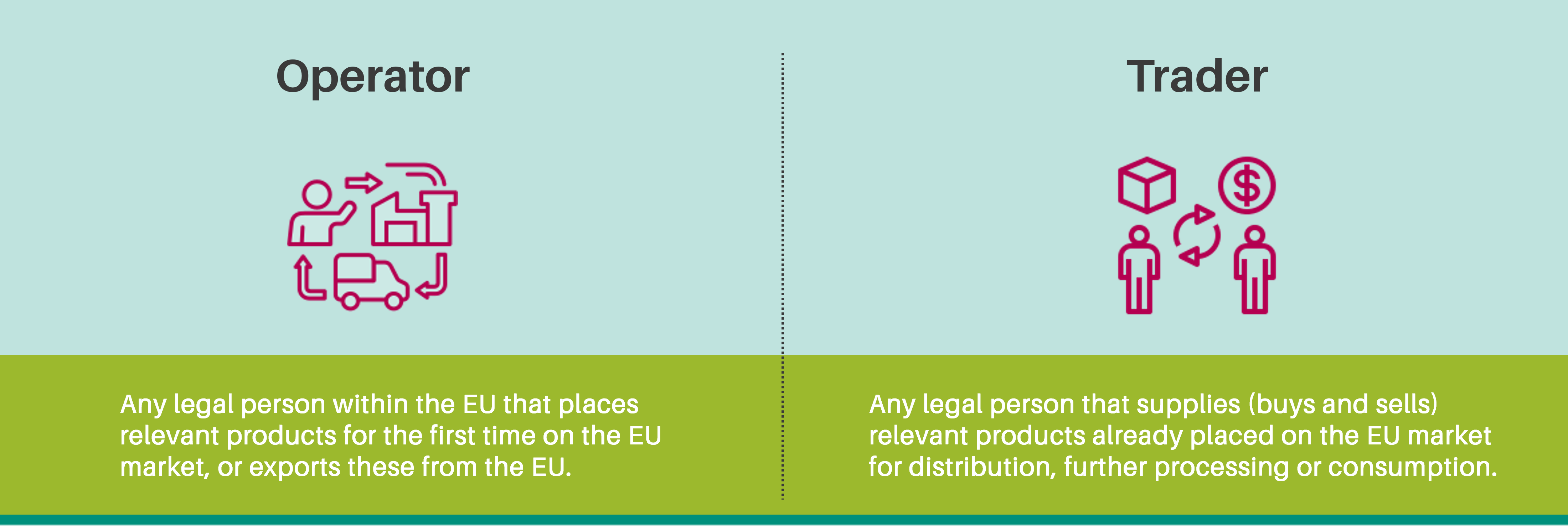
Operators and large Traders have a legal responsibility to demonstrate that these products do not originate from recently deforested land, nor contribute to forest degradation (in the case products derived from or containing, wood).
Unsure if the EUDR applies to your company? Use our self-assessment tool, now available in English, French, German, Spanish and Polish, to help you determine your obligations under the regulation. As part of our commitment to continuous improvement, we have refined and built upon the initial version to bring you version 2.0 of our self-assessment tool.
>> Access our EUDR scoping tool V4.0
When do I need to be ready?
EUDR postponed: New application dates announced
The implementation of the EUDR has been postponed. On 3 December 2024, the European Parliament and European Commission voted to approve the delay, following an agreement reached during the Trilogue negotiations. The amending regulation (EU 2024/3234) formalising this change was then published in the EU’s official journal on 19 December 2024.
The application date for all operators and traders has been extended by 12 months to 30 December 2025. For micro and small businesses established before 31 December 2020 (no date change), the application date is now 30 June 2026, except for wood products covered by the EU Timber Regulation (EUTR), for which the application date remains 30 December 2025.
Most companies must be in compliance with their obligations under the regulation as of 30 December 2025 (date of application). However, some companies will qualify for an extended compliance deadline of 30 June 2026. This extension applies as follows:
| Operators that were established as small or micro-undertakings (as defined by the regulation) before 30 December 2020 are eligible for the extension. | This extension applies to all relevant products listed in Annex I of the EUDR, except those wood products already covered by the EUTR. In other words, there is no exemption in relation to products currently subject to compliance with the EUTR. |

What about the EUTR?
The EU Timber Regulation (EUTR) will be replaced by the EUDR once it comes into force on 30 December 2025. However, the EUTR will still apply for three years for wood products that meet these conditions:
- The trees were harvested before the EUDR came into force (29 June 2023), and
- The wood product is placed on the EU market on or after the EUDR becomes applicable (30 December 2025).
Which commodities are in the EUDR's scope?

| 
| 
| 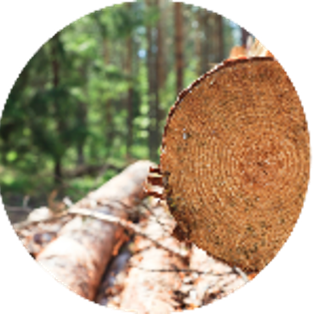
| 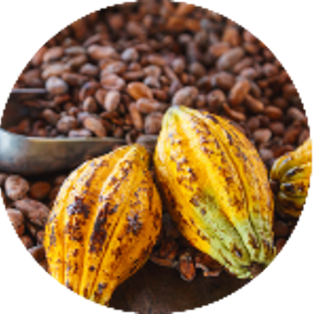
| 
| 
|
The EUDR targets seven vital commodities, considered by the EU to be important in relation the region’s consumption volumes and to deforestation risk: soy, cattle, oil palm, wood, cocoa, coffee and natural rubber.
Which products are covered by the EUDR?
Within each relevant commodity, the regulation defines which products are in scope, according to a list of EU customs codes. Annex I lists the product customs codes for each relevant commodity.
By default, this means that any product or commodity placed on the EU market, or exported from the EU, under a Customs Code not listed in Annex I, can be considered exempt from the regulation.
Within Annex 1 of the regulation, the EU customs codes for relevant products are listed for commodity:
Cattle |
|
|---|---|
Cocoa |
|
Coffee |
|
Oil Palm |
|
Rubber |
|
Soya |
|
Wood |
|
Note: The “ex” prefix indicates that the corresponding product included within Annex I of the EUDR is only part of the entire HS code. A particular customs code may cover a range of products beyond the product referred to in the Annex of the EUDR. However, the prefix "ex" indicates that only a proportion of those products are included.
Composite Products
For composite products, meaning those made from more than one relevant commodity or product, only the component classified as the main commodity is subject to EUDR requirements.
For example, in a chocolate bar, only the cocoa-based ingredients would fall within the scope of the regulation.
Which products are exempted from the EUDR?
EU customs code not listed in Annex 1
Any EU customs code (CN codes) not listed in Annex 1 of the regulation, means that the associated products are considered exempt from the regulation.
Products at the end of their lifecycle
The EUDR does not apply to products made entirely from material that has reached the end of its lifecycle and would otherwise be discarded as waste, except in cases where the material is a by-product of a manufacturing process that involved material not classified as waste (as defined in Article 3, point 1 of Directive 2008/98/EC).
Packaging
Annex I of the EUDR, describes the following:
- Due diligence requirements apply to any wood/paper packaging falling under an Annex I customs code, which is placed on the market or exported as a product in its own right.
- However, packaging falling under CN code 4415 is exempted from the regulation’s requirements when serving as packing material to support, protect or carry another product placed on the market.
The EUDR FAQ provides an update on packaging:
- Packaging material used to support, protect or carry another product placed on the market is not relevant within the meaning of Annex I of the Regulation, regardless of the CN code under which it falls. Thus, the exemption for packaging includes paper and card packing (e.g., those falling under CN 4819).
- User Manuals accompanying shipments are not relevant products, unless purchased independently.
- Selling or renting used packaging material to other companies (like second-hand pallets) is not subject to EUDR.
- Empty used packaging already used for the first time to support, protect or carry another product, for instance, when traded within a closed loop exchange system (e.g., pallets exchanged between companies to be reused for transport) is also outside the scope.
- If used packaging is repaired and sold, only the new relevant materials used in the repair (like new wood parts) must undergo due diligence and a new DDS.
Disclaimer
The information and guidance presented in this webpage are provided for informational purposes only and do not constitute legal, financial, or professional advice. Preferred by Nature makes no representations or warranties, express or implied, regarding the accuracy, completeness, or suitability of the information contained herein. Preferred by Nature is not liable for the use of guidance contained in this website, nor for any reliance placed on this website or any financial or other loss caused because of reliance on information contained herein. Any interpretation of the content of this website, or resulting action taken, is at the sole discretion of the reader, in relation to the European Deforestation Regulation or any other legal statute. The entity subject to legal obligations retains full discretion and accountability for compliance with requirements under the law.
Jump to a specific section:
Deforestation vs forest degradation
Due diligence requirements
Different requirements for different EU actors
Categories of undertakings
Tracing your products and supply chains
Deforestation vs forest degradation
The Regulation sets clear boundaries for relevant products entering or leaving the EU market. In short, they must be deforestation-free and produced in compliance with the legislation of the country of production.
"Deforestation-free" means no room for products containing, being fed with, or made using commodities from land deforested after 31 December 2020. ‘Deforestation’ is described as the conversion of forest to agricultural use, whether human-induced or not.
For products derived from or containing wood, there is an additional requirement: the wood must have been harvested from the forest without causing forest-degradation after 31 December 2020.
Relying on FAO definitions, the EUDR’s definition of ‘forest degradation’ refers to structural changes to forest cover, taking the form of the conversion of primary forests or naturally regenerating forests into plantation forests or into other wooded land, or the conversion of primary forests into planted forests.
The requirement for compliance of production with relevant legislation of the country of production is defined in terms of 8 categories of legislation, listed below:
- land use rights
- environmental protection
- forest-related regulations including forest management and biodiversity conservation, where directly related to wood harvesting,
- third parties’ rights,
- labour rights,
- human rights protected under international law,
- the principle of free, prior and informed consent, including as set out in the United Nations Declaration on the Rights of Indigenous Peoples,
- tax, anti-corruption, trade and customs regulations
Due diligence requirements
If you are placing relevant commodities or products onto the EU market, or exporting them from the EU, you are considered an Operator. You must implement a due diligence system, the details of which are prescribed in the regulation. This means implementing procedures and measures to ensure that your products come from sources that are deforestation-free or comply with the country's laws.

Operators need to gather supply chain information, assess risks of non-compliant supply chains, and take necessary actions to mitigate any identified risks of sourcing non-compliant commodities or products.
Risks must be mitigated, and products deemed to be negligible risk in relation to their deforestation-free or legal compliance before placing them on the EU market or exporting them from the EU. Operators must also publicly report their due diligence efforts each year.
Country Benchmarks and simplified due diligence requirements
The European Commission will establish a centralised database of country risk assessments ('country benchmarks' as per the regulation) to streamline due diligence and enforcement. Countries will be categorised as low, standard, or high risk based on their association with deforestation.
Operators sourcing from 'low-risk' countries will be able to enjoy a more simplified due diligence process, but they still need to carefully assess their supply chains for potential risks of mixing with products which are not in conformance with the regulation.
Enforcement efforts will be tailored to match the risk levels also, with increased monitoring by Competent Authorities for high-risk countries and a lighter approach for low-risk ones.
Using certification schemes to meet due diligence requirements
The EUDR recognises that certification or other third party verified schemes represent best practice in the forestry and agricultural sectors. It considers that they have a place - and can be used - in risk assessment or mitigation processes.
However, the regulation is also clear that they should not substitute the operator’s responsibility regarding due diligence. Certification schemes need to be evaluated to assess their coverage, credibility and ability to provide assurance of mitigated risks.
Different requirements for different EU actors
Depending on the size of your business and the nature of your operations, your responsibilities may differ from Operators which are importers or exporters as described above:
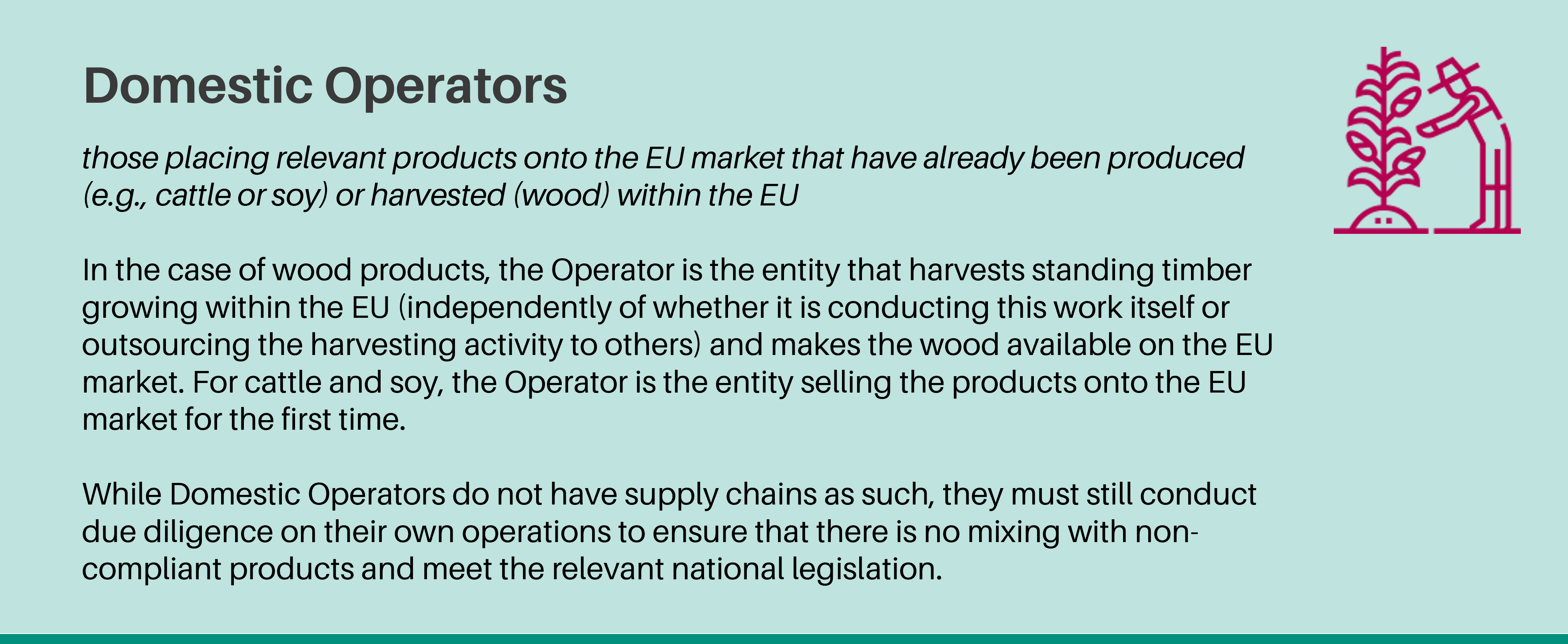
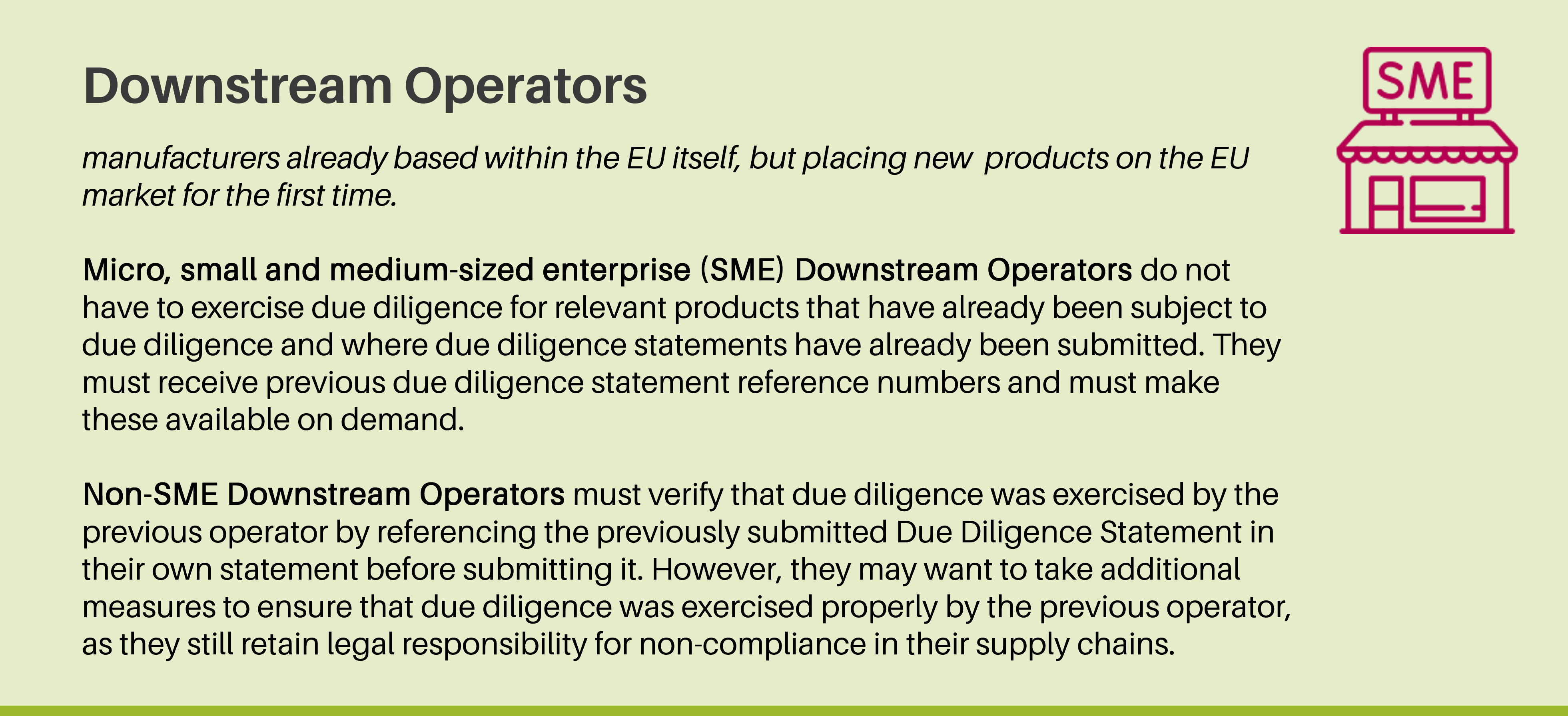

Categories of undertakings: must not exceed the limits of at least two of the three following criteria (large undertakings must exceed the limits of at least two):
Micro-undertakings
| Small undertakings
|
Medium-sized undertakings
| Large undertakings
|
Unsure if the EUDR applies to your company? Use our self-assessment tool, now available in English, French, German, Spanish and Polish, to help you determine your obligations under the regulation. As part of our commitment to continuous improvement, we have refined and built upon the initial version to bring you version 4.0 of our self-assessment tool.
>> Access our EUDR scoping tool V4.0
Tracing your products and supply chains
Operators and Non-SME Traders need to gather detailed information and data to be able to demonstrate that their products are deforestation-free and produced in accordance with the legislation of the country of production.
That means knowing exactly where your commodities or products come from – including the geolocation coordinates of all plots of land where they were produced, or harvested in the case of wood and raised in the case of cattle.
For smaller plots, a single latitudinal and longitudinal point will be sufficient. But for plots over 4ha in size, you will need sufficient latitudinal and longitudinal points to describe each plot's perimeter.
A comprehensive central Information System is being developed by the European Commission to efficiently manage Operators' due diligence statements and customs clearance applications, ensuring transparency and ease of compliance.
Disclaimer
The information and guidance presented in this webpage are provided for informational purposes only and do not constitute legal, financial, or professional advice. Preferred by Nature makes no representations or warranties, express or implied, regarding the accuracy, completeness, or suitability of the information contained herein. Preferred by Nature is not liable for the use of guidance contained in this website, nor for any reliance placed on this website or any financial or other loss caused because of reliance on information contained herein. Any interpretation of the content of this website, or resulting action taken, is at the sole discretion of the reader, in relation to the European Deforestation Regulation or any other legal statute. The entity subject to legal obligations retains full discretion and accountability for compliance with requirements under the law.
Info sheet

EUDR Service Info Sheet
The EU Deforestation Regulation (EUDR) prohibits products and commodities linked with deforestation and forest degradation from being imported into the EU market or exported from ...
The EU Deforestation Regulation (EUDR) prohibits products and commodities linked with deforestation and forest degradation from being imported into the EU market or exported from ...
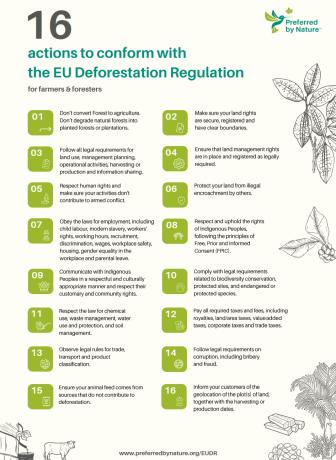
16 actions to conform with the EU Deforestation Regulation
This document outlines actions that farmers and foresters can take to conform with the EU Deforestation Regulation.
This document outlines actions that farmers and foresters can take to conform with the EU Deforestation Regulation.
Template

Guidelines for EUDR Due Diligence System preparation
This document provides clear instructions and practical steps for preparing Due Diligence Systems (DDS) to meet the requirements of the EU Deforestation Regulation (EUDR). It is d...
This document provides clear instructions and practical steps for preparing Due Diligence Systems (DDS) to meet the requirements of the EU Deforestation Regulation (EUDR). It is d...
Preferred by Nature Certification Standards

Preferred by Nature Certification - EU Deforestation Regulation aligned Indicators
To address the EUDR requirements, for agricultural commodities and wood products respectively, we have benchmarked the 157 indicators included in our Sustainability Framework with...
To address the EUDR requirements, for agricultural commodities and wood products respectively, we have benchmarked the 157 indicators included in our Sustainability Framework with...
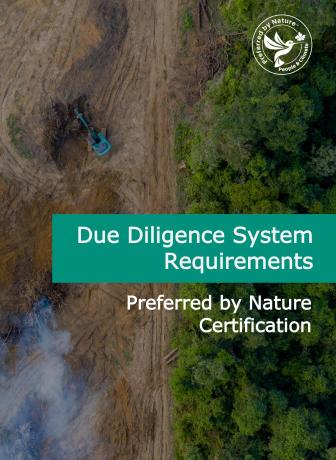
Preferred by Nature Certification - Due Diligence System Requirements
This Standard sets out requirements for organisations that want to demonstrate compliance with the Sustainability Framework for specified products in their supply chains. The Stan...
This Standard sets out requirements for organisations that want to demonstrate compliance with the Sustainability Framework for specified products in their supply chains. The Stan...
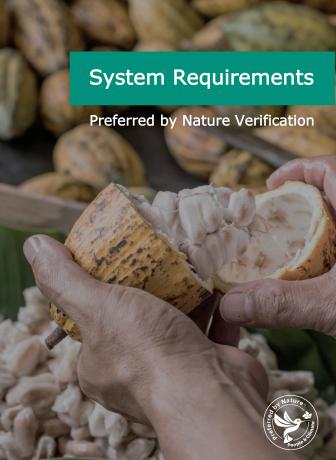
Preferred by Nature Certification - System Requirements V1.4
This document is relevant to all organisations seeking Preferred by Nature Certification, encompassing both land use and supply chain sectors. It outlines the essential requiremen...
This document is relevant to all organisations seeking Preferred by Nature Certification, encompassing both land use and supply chain sectors. It outlines the essential requiremen...
Geospatial Data Sharing Protocol
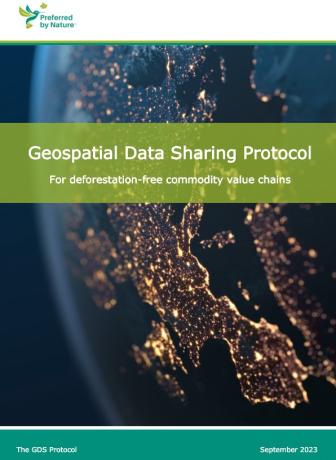
Geospatial Data Sharing Protocol For deforestation-free commodity value chains
The Protocol is intended to be a voluntary standard for providing a uniform means for sharing geospatial data. This will allow organisations to exchange geospatial data efficientl...
The Protocol is intended to be a voluntary standard for providing a uniform means for sharing geospatial data. This will allow organisations to exchange geospatial data efficientl...
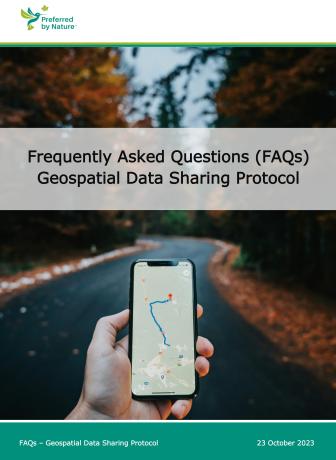
Frequently Asked Questions (FAQs) - Geospatial Data Sharing Protocol
This document outlines all the frequently asked questions related to the Geospatial Data Sharing (GDS) Protocol. It aims to provide clarity and understanding for those interested ...
This document outlines all the frequently asked questions related to the Geospatial Data Sharing (GDS) Protocol. It aims to provide clarity and understanding for those interested ...
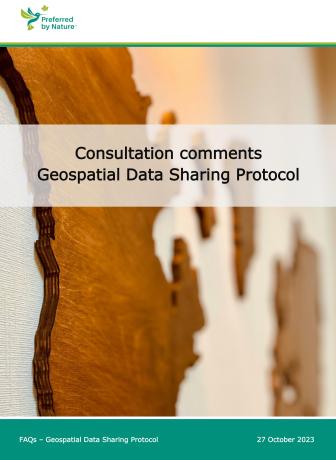
Consultation comments - Geospatial Data Sharing Protocol
The Geospatial Data Sharing (GDS) Protocol's first version was developed in mid-2023 with FAO's support to improve commodity production monitoring. Following expert group input a...
The Geospatial Data Sharing (GDS) Protocol's first version was developed in mid-2023 with FAO's support to improve commodity production monitoring. Following expert group input a...
Videos
Get in contact with us
Our experts are ready to support you on your sustainability journey.

